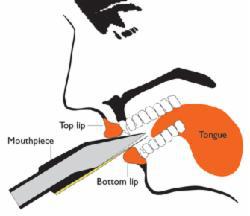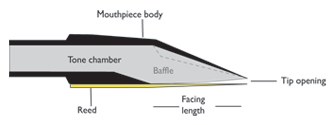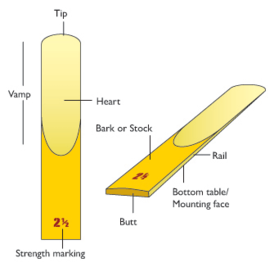Adjustment
When a horn becomes slightly harder to play, it may need adjusting. Over time the pads start wearing, moving or shrinking which makes the notes harder to play. This is the time when the horn may need to be looked at by a qualified repairer to adjust the pads and tone hole covers to re-seat them correctly.
Baffle
A step inside the mouthpiece tone chamber that produces an interruption to the air supply as it passes through the mouthpiece. The larger the baffle (or step),the more interrupted the air and 'dirtier' the sound. Some players have been known to stick lumps of plastercine in their mouthpieces to give the same effect!
Bell
The widest part of the horn where the most of the noise comes out.
Body
The main upright piece of the sax on which most of the keys, tone holes and tone covers are situated.
Bow
The u-shaped bottom piece of the horn that connects the body to the bell.
Cork
Cork is glued around the end of the crook so the mouthpiece fits snugly onto it.
Cork Grease
Grease used for rubbing into the crook cork enabling the mouthpiece to move along the cork for tuning purposes. Mostly in the form of a 'lipstick' it keeps the crook cork moist and conditioned.
I did have one student whose mouthpiece was stuck fast to the cork. Had it been tuned correctly it wouldn't have been so much of a problem. But it was more by luck than judgement that mouthpiece was freed without breaking something!
Crook
The top part of the sax that links the body to the mouthpiece.
Embouchure
The term used for the placing of your chops around the mouthpiece.
The recommended embouchure suggests placing your front teeth on top of the mouthpiece, about half way up the up the slope, with the top lip in front of the teeth forming the seal. The bottom lip can either be placed naturally around the bottom forming a seal, or can be curled back slightly for more comfort (a little like an oboe). Once you are confident about getting a good sound, you can experiment further with the position of your mouth on the mouthpiece. Some people (myself included) develop a style where the top lip is folded under the top teeth. It's all a matter of individual comfort and style.

Fingering
The order or placement of fingers to obtain all the notes on the horn. The fingering is the same for all models of saxophone, although the position of the fingers can change slightly between saxohpone makes.
Growling
The 'dirty' sax sound obtained by humming or grating the back of the throat while blowing. Humming whilst blowing produces a mild 'texture' to the sound, while grating the back of your throat produces a much 'rougher' sound. Growling is great for effects in rock 'n' roll for example. It does, however, take some practice as it is quite an un-natural thing to do.
Key
The areas pressed by the fingers to operate a tone hole cover (a note),inset with coloured pearl or plastic lookalike.
Lay or Facing
The facing or opening of the mouthpiece that curves away from the reed. A larger lay means a wider gap between reed and mouthpiece which in turn makes a horn slightly harder to blow. However, a larger gap does means more 'unused' air goes through the horn which produces the sensuous 'breathy' sax sound on the lower notes.
Ligature
The device used to hold the reed onto the bottom face of the mouthpiece. The ligature needs to be tight enough to hold the reed securely, but not too tight to restrict the natural vibration of the reed. The ligature should sit just behind the 'heart' of the reed. Moving the ligature back on the mouthpiece body slightly will allow more of the reed to vibrate, thus making the lower notes slightly easier to play.
'Lipping up'
As no two saxophones will ever be in precise tune with each other, some notes will need 'lipping up' and some 'lipping down'. This is the process of tightening or relaxing your chops around the mouthpiece to alter very slightly the pitch of a note. 'Lipping up' or tightening your embouchure will make a note sharper; 'lipping down' or relaxing your embouchure will make a note flatter. The middle C-sharp on some alto horns, for example, tends to play flat and so needs lipping up to stay in tune.
Lyre
A small music holder that fastens to the top of the sax body. Used mainly by marching band players. The screw for the lyre is usually next to the screw for tightening the crook to the body. It is worth checking this every now and then as, through lack of use, I have known this to work itself loose.
Mouthpiece
The bit that your chops seal around which, along with the reed, starts the noise process. Without being attached to the horn, this produces a 'squeak' when blown.
Pad
Usually made from leather, the pad is glued inside the tone hole cover. This forms an effective seal when pressed shut on to the tone hole. It's unfortunate that moisture and leather don't go together. Hence, your sax will need some or all of it's pads replacing every few years.

Pearl
The keys are sometimes inlaid with pearl for aesthetics. Most, however are just coloured plastic.
Post
A welded support protruding from the anywhere on the sax that supports a rod.
Plastic reeds
A relatively new product, these reeds are identical in every respect to 'nature's' reeds, but they are made entirely from plastic. They are far more reliable than 'normal' reeds as they don't 'wrinkle' as soon as they get wet, and they're much more durable. They are, however, more expensive than the 'normal' ones. You can also get 'normal' cane reeds which are coated with a thin layer of plastic - a kind of half and half!
Reed
Usually made from natural cane, the reed attaches to the mouthpiece with the ligature. Using airflow to produce vibration, the reed is where the process of getting a sound from your horn starts. As saxophones are different sizes, so are the reeds to suit the relevant model of sax, although all reeds look basically the same and operate in the same way.
Reed holder
The plastic or card holder that reeds are sold with. These not only protect the reed while being stored, but also (more importantly) keep them flat.
Reed strength
Softer reeds, or reeds that have been scraped thinner, vibrate more readily and are therefore easier to play. Beginners tend to start on a strength one-and-a-half reed. As players progress and develop, they move up to harder strength reeds which allow a better development of tone and sound. Reed strengths go up to five, although most pro sax players tend to play with reed strengths two-and-a-half to three-and-a-half.

Rod
A long bar that runs the length of the sax body in order to operate a tone hole cover remotely.
Sling or Strap
A neckstrap or other device used to take the weight of the sax around the player's neck.
Soft reed
A reed produced from softer reeds which makes a horn easier to play, but doesn't allow as much tone control.
Spring
Usually a thin metal strip or 'pin' that holds a tone hole cover open or closed.
Tip opening
The gap between the reed tip and the pointy-bit of the mouthpiece, determined by the lay (see above). This gap is smaller in beginners' instruments to enable ease of playing.
Tone hole
The holes pressed or cut into the sax. In cheaper horns, the tone holes are soldered to the body, whereas more expensive horns have holes that are pressed/shaped from the body's metal and therefore no soldered joints.
Tone hole cover
The 'lid' that closes on each tone hole to make each note. The tone hole cover is made from a brass 'cup' with a leather pad glued inside it. Some early horns like the Buescher had a 'popper' soldered to the inside of the tone hole cover which the leather pads were pressed or 'popped' into. As these early leather pads are getting more tricky (and more expensive) to find, one option when re-padding is to grind off the 'poppers'. This leaves the tone hole free to accept a more modern leather pad to be glued in with no problem.
Tonguing
The starting and stopping of a note crisply and cleanly by touching the reed with your tongue. This immediately stops the reed from vibrating and so stops the sound. This can take some time to perfect and some people find it tickles!
Trick notes
These are notes or sounds obtained by using 'non-standard' fingering. There are many effects that can be obtained through various combinationsof fingering - the best way to discover these is to experiment!